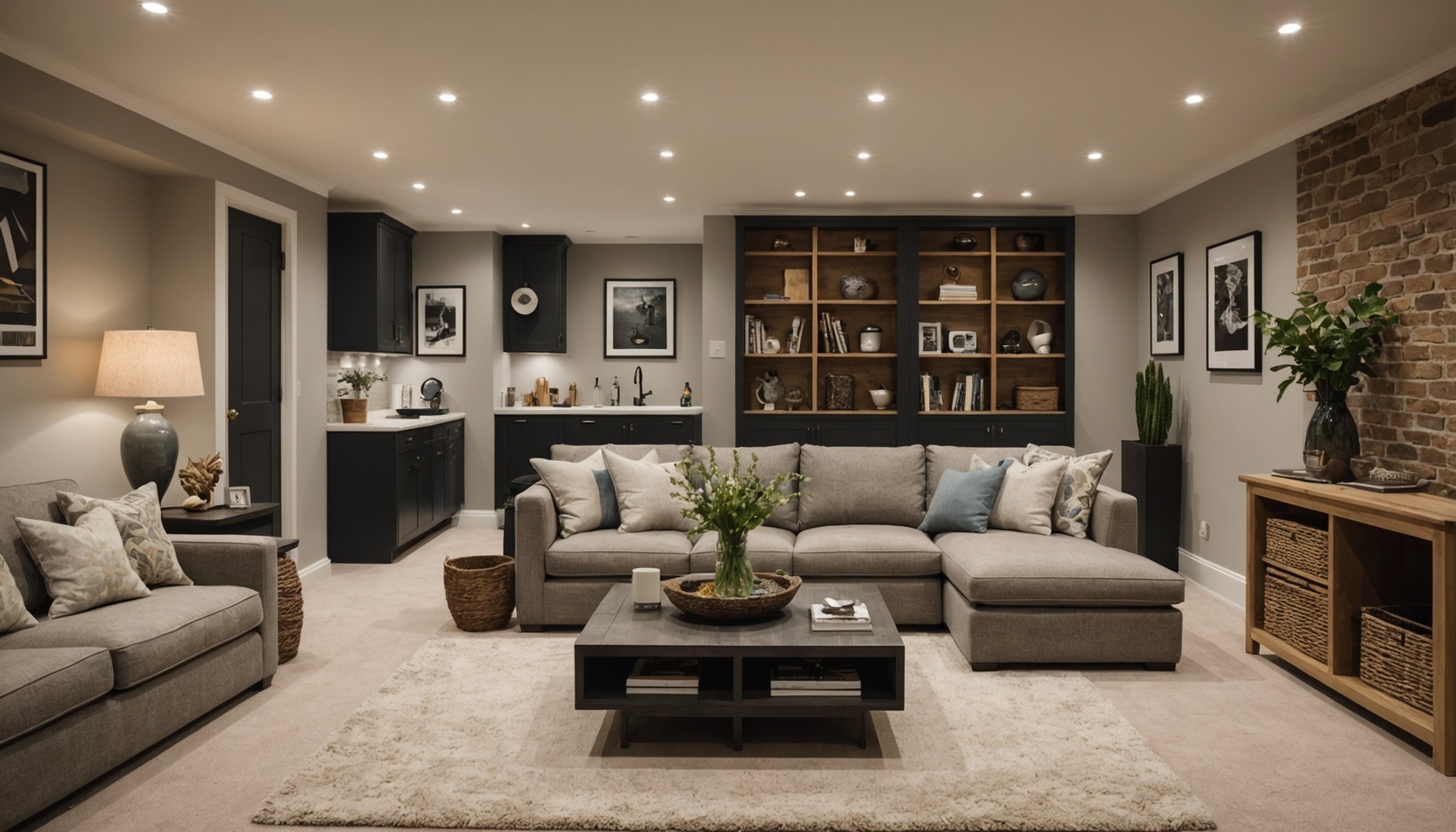Practical Tips for Transforming Your Basement
When considering a UK basement conversion, the first step is to thoroughly evaluate your current space. Assess the layout and potential of your basement to identify opportunities and limitations. This preliminary analysis will guide the direction of your renovation project.
Budgeting is essential in a basement transformation project. Outline all possible expenses, including construction, materials, and labour. Consider unexpected costs to ensure you stay within your financial plan. Setting a realistic budget will prevent financial strain as the project progresses.
Also to read : Evaluating the Long-Term Durability of UK Real Estate Investments in the Face of Climate Change
Envisioning the end use of the basement is crucial before starting any renovation. Whether you aim for a quiet home office, a vibrant playroom, or a cosy media centre, having a clear vision from the start will inform every decision. Make sure to tailor the space to meet your needs and lifestyle.
Take these factors into account and carefully organize your project. Each step in your renovation, from budgeting to design, should be aligned with your goals. By considering these home renovation advice, you can effectively transform your basement into a functional and appealing extension of your home.
Additional reading : Navigating UK Property Inheritance Tax: Your Ultimate Planning Handbook
Design Inspiration for Chic Basements
Transform your basement into a stylish, multifunctional space with the right basement design ideas. The possibilities for decor and design are endless, allowing you to create a chic environment that aligns with your vision.
Maximizing Natural Light
Incorporate innovative methods to maximise natural light in your basement. Skylights and light wells can enhance brightness, while strategically placed mirrors can reflect light throughout the space. This alleviates the often dim atmosphere typical of basements, making them more inviting.
Colour Schemes and Materials
Choosing the right colour scheme and materials is crucial. Opt for bright colours to create an open feel, helping offset the enclosed nature of basement spaces. Durable materials like waterproof flooring and moisture-resistant paints are essential to withstand the unique conditions of a basement, effectively balancing aesthetics with practicality.
Furniture Selection and Arrangement
Select furniture that enhances functionality and style. Consider modular pieces that promote flexibility, accommodating various activities without crowding the space. Proper furniture arrangement optimises the layout, ensuring the basement serves multiple purposes. By balancing design and functionality, your basement can become a beloved part of your home.
Renovation Considerations and Strategies
Renovating a basement is an extensive process divided into three main stages: planning, construction, and finishing. At the core of any good basement renovation strategy is understanding these stages thoroughly. During planning, budget estimation and timeline creation are pivotal. In the construction phase, clear consideration of any alterations to plumbing and electrical systems is essential, ensuring compliance with all safety measures.
Choosing between DIY or hiring professionals can significantly impact your project. DIY can offer savings but demands technical knowledge and a substantial time investment. Hiring professionals can streamline the process, ensuring expertise and quality but often at a higher cost. Evaluating your skills and available time will guide this decision, aiming for efficiency and reliability.
Key considerations for plumbing and electrical work in basements cannot be overlooked. Assess the capacity of existing systems, as they might need upgrading to accommodate new spaces. Safety standards and regulations must be adhered to, preventing potential hazards. Proper insulation, protection against moisture, and strategically placed electrical outlets contribute significantly to a reliable, functional construction process. Make informed choices for a smooth renovation journey.
Legal Regulations for Basement Conversions
When planning a UK basement conversion, understanding building regulations and obtaining necessary approvals are crucial steps. Before embarking on construction, homeowners must secure the appropriate permits. This ensures the basement meets all safety standards and adheres to local bylaws.
Planning Permission and Approvals
Securing planning permission is often required, especially if the conversion alters the building’s exterior or changes its use. Engaging with local authorities early can streamline this process. Understanding your local zoning laws will aid in knowing any specific requirements related to your property.
Building Codes and Safety
Compliance with safety standards involves understanding the specific building codes that pertain to basements. Factors such as ceiling height, emergency exits, and fire safety measures must be considered to ensure safety and legality. Codes may vary by region, so consulting a professional familiar with your local regulations is beneficial.
By focusing on understanding regulations from the outset, you can prevent costly delays and potential legal issues. Tailoring your approach to meet these legalities not only ensures compliance but also adds value to your home. With careful planning and adherence to regulations, your basement transformation can be both successful and legally sound.
Insulation and Moisture Management
Basements, especially in the UK climate, require special attention to insulation and moisture management. A well-insulated basement not only ensures comfort but also enhances energy efficiency.
Best practices for insulating basement walls involve using materials like foam board insulation or spray foam, which provide excellent thermal resistance and moisture barriers. These materials adapt well to the often variable temperatures of basements, maintaining a stable internal environment.
Preventing dampness and moisture build-up is crucial. Effective drainage systems, such as sump pumps and perimeter drains, can alleviate water accumulation. Additionally, applying waterproof sealants to walls and floors acts as an extra barrier to moisture.
Ventilation systems also play a significant role in moisture control, promoting air circulation and reducing humidity. Consider mechanical ventilation systems with heat recovery to ensure a fresh air supply without energy loss.
In summary, addressing insulation and moisture management is key to maintaining a dry, comfortable, and energy-efficient basement. Investing in these aspects early on can prevent costly issues later and contribute to a long-lasting renovation success.
Effective Lighting Solutions
Exploring basement lighting ideas can radically change your space’s atmosphere and utility. Understanding the significance of layered lighting—a mix of ambient, task, and accent lights—helps cater to various activities while enhancing the room’s mood. This strategy creates depth and adds a warm, welcoming vibe to your basement.
Ideas for Incorporating Both Natural and Artificial Lights
Optimise your functional lighting design by leveraging both natural and artificial sources. Basements typically lack windows, making innovative solutions like light wells essential to draw in natural light. Combine this with energy-efficient LEDs or smart bulbs to maintain effective lighting levels, adjusting to your needs.
Energy-Efficient Lighting Options for Cost Savings
Consider energy-efficient options like LEDs, CFLs, and motion-sensor lights to cut costs and reduce your carbon footprint. These options provide excellent light output while consuming a fraction of the energy compared to traditional lighting. You maintain bright, functional spaces without the hefty utility bills.
By meticulously planning your lighting strategy, incorporating layers of lighting, and choosing energy-efficient options, you can create a mood lighting experience that is both beautiful and functional in your basement transformation.
Smart Storage Solutions
Unlock the potential of your basement with innovative basement storage ideas that elevate space-maximising strategies. Creative storage solutions are key to transforming a cluttered basement into an organised sanctuary. Begin by investing in modular shelving units that adapt to the unique layout of your basement. These can be customised to fit snugly into tight corners or along expansive walls, offering ample storage without sacrificing usability.
Utilising vertical space is another game-changer in achieving an organised living environment. Install high-reaching shelves or floating units to store seldom-used items, keeping them accessible yet out of the way. This thoughtful arrangement frees up floor space, maintaining an open, airy feel even in compact areas.
For truly personalised solutions, consider custom storage options tailored to your basement’s unique specifications. Built-in cabinets with adjustable compartments or under-stair storage can address specific needs while blending seamlessly with the room’s aesthetics.
Incorporating these strategies not only declutters your space but also enhances the overall functionality and appeal of your basement. By maximising storage efficiency, you turn your basement into a versatile extension of your home, ready to accommodate various activities and lifestyles.
Case Studies: Successful Basement Conversions
Discover a wealth of inspiration through basement conversion examples showcasing homeowner success stories from the UK. These transformation highlights offer valuable insights into the potential of creatively transformed basements and feature unique elements within their designs.
One standout project involved converting a compact basement into a multifunctional space combining a home office, gym, and media centre. This transformation cleverly utilized custom-built shelving and smart storage solutions to maximize the small area, ensuring each function was distinct yet seamlessly integrated. Homeowner feedback emphasized how the new layout improved their daily routine, providing both work and leisure facilities within their home.
Another captivating basement conversion repurposed an old, unused basement into a stylish guest suite featuring an en-suite bathroom. By incorporating ambient lighting and using light, neutral colours, the space became welcoming and lively—a testament to intelligent design choices for challenging basement conditions. The homeowners praised the upgrade, citing enhanced property value and newfound hospitality options.
These case studies not only highlight the aesthetic appeal and practicality of innovative basement renovations but also underscore the benefits of thoughtful design in enhancing and expanding living spaces.

